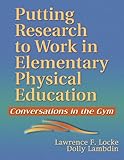Putting research to work in elementary physical education : conversations in the gym / Lawrence F. Locke, Dolly Lambdin.
Publication details: Champaign, IL : Human Kinetics, 2003.Description: xxv, 206 p. ; 29 cmISBN:- 0736045317 (pbk.)
| Item type | Current library | Home library | Collection | Call number | Materials specified | Copy number | Status | Date due | Barcode | |
|---|---|---|---|---|---|---|---|---|---|---|
| AM | PERPUSTAKAAN TUN SERI LANANG | PERPUSTAKAAN TUN SERI LANANG KOLEKSI AM-P. TUN SERI LANANG (ARAS 5) | - | GV362.L627 (Browse shelf(Opens below)) | n.2 | 1 | Available | 00001362741 | ||
| AM | PERPUSTAKAAN TUN SERI LANANG | PERPUSTAKAAN TUN SERI LANANG KOLEKSI AM-P. TUN SERI LANANG (ARAS 5) | - | GV362.L627 (Browse shelf(Opens below)) | n.1 | 1 | Available | 00001347526 |
Includes bibliographical references (p. 200-203) and index.
The basics--numbers, time, space, equipment, and behaviors. How equipment and class size make a difference. Who gets the teacher's attention? More days per week equals more learning. Modifying equipment to fit the students -- Managing the class. Reducing disruptive student behaviors. Active supervision and student learning. Teaching social behaviors. Recording and classifying teacher management behaviors. Teaching fair play in the gym and school -- Interactions among students. Using trained peer tutors. Peer-mediated accountability and successful practice -- Strategies for teaching and learning. Can learners guide their own practice with self-talk? Using environmental cues to guide practice -- The voices of students. Kindergarten children describe physical education. Third-grade children describe physical education. Children describe the mile-run fitness test. Children describe what they learn in physical education. High school seniors recall elementary physical education -- Teachers in the workplace--training, experience, and context. Preservice classroom teachers in the gym. Is daily physical education worth the price? The impact of inclusion on physical education teachers. How five years of experience changed a teacher. How veterans and rookies planned a class -- Assessment as part of teaching. Using skill assessment to build effective lessons. Is peer assessment both practical and accurate? -- The SPARK studies, a program for teachers and children. The impact of SPARK on children's fitness and activity. The impact of SPARK on catching, throwing, and kicking. How well do children like various P.E. activities? -- Reviewing studies of the effects of physical education. The legacy of elementary school physical education. Twenty-year follow-ups of participants in a model program -- Conclusion, finding different ways to make research serve teaching.
There are no comments on this title.

